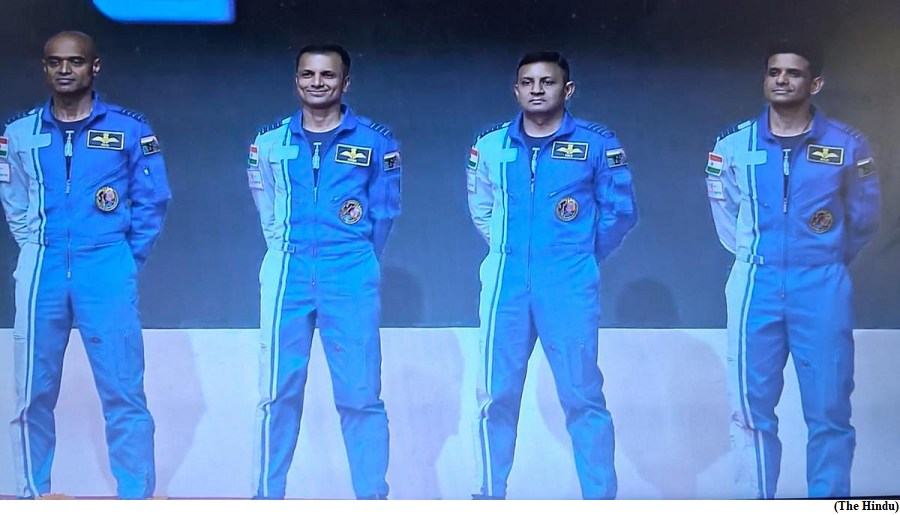4 IAF pilots named as possible Gaganyaan crew (GS Paper 3, Science and Technology)

Why in news?
- India recently announced the names of the four astronaut-designates for the Gaganyaan human spaceflight mission, planned for launch in 2025.
Shortlisted crew:
- The names of the Indian Air Force (IAF) pilots: Group Captain Prasanth Balakrishnan Nair, Group Captain Ajit Krishnan, Group Captain Angad Pratap and Wing Commander Shubhanshu Shukla were revealed for the first time.
- The final crew for the mission will be picked from among the four.
- Shortlisted through a rigorous selection process, they have been undergoing training in various aspects of space flight, initially in Russia, and later at the Astronaut Training Facility established by the Indian Space Research Organisation (ISRO) in Bengaluru.
Gaganyaan programme:
- The Gaganyaan programme is designed to demonstrate indigenous capability to undertake human space flight mission to Low Earth Orbit (LEO).
- The mission is expected to pave way for a “sustained Indian human space exploration programme” in the long run.
- In the run-up to the crewed mission to LEO, ISRO is in the process of conducting various tests. These include the Integrated Air Drop tests, Test Vehicle Missions, pad Abort Tests. There will be unmanned flights before the actual flight.
- ISRO has also announced plans to send astronauts to the moon by 2040.
Technical facilities:
- Recently, three technical facilities developed at a cost of about ₹1,800 crore were dedicated to the nation.
- This includes a state-of-the-art Trisonic Wind Tunnel at the VSSC, integration facilities for the Polar Satellite Launch Vehicle (PSLV) at the Satish Dhawan Space Centre, Sriharikota, and the Semi-cryogenic Integrated Engine and Stage Test Facility (SIET) at the ISRO Propulsion Complex (IPRC) at Mahendragiri, Tamil Nadu.
Trisonic Wind Tunnel at the VSSC:
- The Trisonic Wind Tunnel produces a controlled uniform airflow over scale models of rockets and aircraft to assess their aerodynamic characteristics.
- It is designed to make ISRO self-reliant in the end-to-end design of upcoming launch vehicle projects.
PSLV Integration Facilities (PIF):
- The PSLV Integration Facilities (PIF) at Sriharikota will give ISRO the capability to increase the number of PSLV missions in a year from 6 to 15.
Semi-cryogenic Integrated Engine and Stage Test Facility (SIET):
- SIET will be used to test the SCE-2000 semi-cryogenic engine and stages which will increase the payload capability of the launch vehicles.
Newfound obelisks join viruses, viroids as third unusual life form
(GS Paper 3, Science and Technology)
Context:
- Recently, scientists at Stanford University have reported an extremely simple, and unusual, form of life.
- When analysing genetic material from bacteria present in the human gut, the scientists identified a new form of life lying between viruses and viroids on the scale of simplicity. They called them ‘obelisks’.
- The discovery was made possible using data obtained using a powerful technique called next-generation sequencing (NGS), which allows researchers to parallelly determine genome sequences, in bits and pieces from different organisms.

Viruses:
- For nearly seven decades since their discovery in 1898, viruses were the only organisms at the boundary between the living and the non-living. Their obligate host dependence, parasitism, and small genome sizes collectively made sure they weren’t classified as ‘life’ per se.
- Each virion is composed of a nucleic acid (DNA or RNA) core that serves as the genetic material, surrounded by a protein coat, and, in some cases, a lipid (fat) layer outside that coat.
- Viruses’ infect a host cell, use the cell’s machinery to make more copies of themselves, then infect a new cell to repeat the cycle.
Discovery of obelisks:
- They discovered obelisks when they were analysing RNA from all the bacteria present in the human gut using NGS, while specifically looking for viroid-like elements.
- They team analysed 5.4 million publicly available sequence datasets of RNA from bacteria in the human gut using this method. In 220,000 of them, it identified 29,959 distinct obelisks.
- They proceeded to search for obelisks in the RNA datasets of bacteria found in the human mouth as well, and found them in approximately half of the sets. Further searches revealed obelisks were present in human-gut and -oral bacteria from all seven continents as well, demonstrating their ubiquity.
- Finally, they y set about ascertaining the degree of similarity of obelisks to viroids. They observed that while both organisms do have circular RNA for genomes, the similarity ended there.
- The obelisk RNA was much longer and appeared to code for two proteins, neither of which bore any similarity to any known protein from any other life form.
Link to S. sanguine:
- Despite its ingenuity, the new study suffers from one minor limitation: since the team was analysing RNA data from all the gut or oral bacteria put together, it was impossible to determine which bacteria hosted a given obelisk.
- This issue notwithstanding to demonstrate proof of the notion that obelisk sequences are indeed a part of data from the bacterial hosts, managed to analyse all the RNA from a few bacteria individually grown in the laboratory.
- This way, they managed to link one particular obelisk to the bacterial species Streptococcus sanguini, commonly found in the human mouth.



